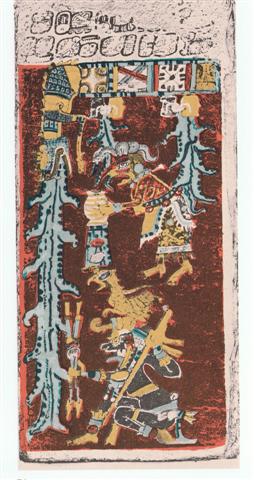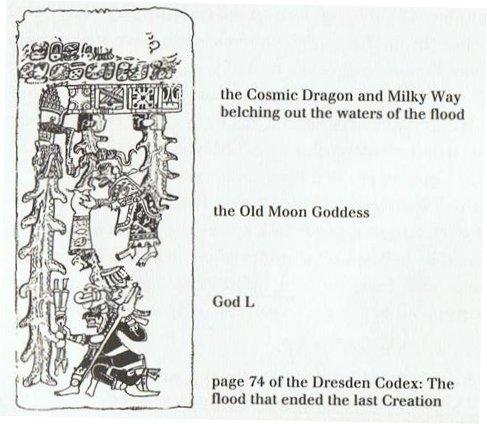Where was 2-14 at the
time of Bharani? Day 400 ("February 4)
was at φ Pegasi - which star in
rongorongo times was 361 (= 19 * 19)
days after 0h - and we have to add only
10 days. I.e., 361 + 10 = 371 = 365 + 6
= March 27 corresponded to "February 14
at Ga3-17:
 |
 |
 |
|
 |
 |
 |
|
Gb3-11 |
Gb3-12 |
Gb3-13 |
Gb3-14 (75) |
Gb3-15 |
Gb3-16 (306) |
|
JANUARY
16 |
17 |
18 |
19 (384) |
20 |
21 |
|
Al
Fargh al Thāni-25 |
Uttara Bhādrapadā-27
/
Wall-14 |
χ Pegasi (2.1), θ Andromedae
(2.7) |
σ Andromedae (3.0), ζ Tucanae
(3.5), ρ Andromedae, π Tucanae
(3.7) |
no star listed (4) |
Ankaa,
κ Phoenicis
(5.0)
Alphard |
|
0h (365.25) |
|
Caph,
SIRRAH
(0.5), ε Phoenicis (0.8) |
ALGENIB
PEGASI
(1.8) |
|
March
21 (0h) |
22 |
23 |
24 |
Equinox (84) |
26 (450) |
|
°March 17 |
18 |
19 |
20 |
°March
21 (0h) |
22 |
|
'February 22 |
Terminalia |
Bissextum (*340) |
25 (56) |
26 (422) |
27 |
|
"February
8 |
9 (40) |
10 (*326) |
11 |
12 (408) |
13 |
|
NAKSHATRA DATES: |
|
JULY
18 |
19 (200) |
20 (*121) |
|
21 |
22-7 |
23 |
|
Alchita,
Ma Wei (183.1),
Minkar
(183.7), ρ Centauri (183.9) |
Pálida (184.6), Megrez (184.9) |
Hasta-13 /
Chariot-28 |
Chang Sha
(186.3) |
Intrometida (187.4),
Acrux
(187.5) |
γ
Com. Berenicis (188.0), σ
Centauri (188.1),
Algorab
(188.5), Gacrux (188.7)
|
|
GIENAH
(185.1), ε Muscae (185.2), ζ
Crucis (185.4),
Zaniah
(185.9) |
|
September
20 |
21 |
Equinox (265) |
23 |
24 |
25 |
|
°September 16 |
17 |
18 |
19 |
20 |
21 (*184) |
|
'August
24 (236) |
25 (*157) |
26 |
27 |
28 |
29 |
|
"August
10 (222) |
11 |
12 (*144) |
13 |
14 |
15 |
 |
 |
 |
|
Gb3-17 |
Gb3-18 (308) |
Gb3-19 |
|
JANUARY
22 |
23 (388) |
24 |
|
λ Phoenicis (6.3), β
Tucanae (6.4) |
Andromeda Galaxy,
π Andromedae
(7.7) |
ε Andromedae
(8.2),
Delta
(8.4), Schedir (8.6),
ζ Andromedae,
μ Phoenicis (8.9) |
|
March
27 |
28 (452) |
29 (88) |
|
°March 23 |
24 (448) |
25 (84) |
|
'February 28 |
'March 1 (425) |
2 (61) |
|
"February
14 (2-14) |
15 (46) |
16 (*332) |
|
NAKSHATRA DATES: |
|
JULY
24 |
25 (206) |
26 (*127) |
|
γ Muscae (189.0),
Avis
Satyra (189.3),
Asterion (189.5),
Kraz (189.7) |
α Muscae (190.2), τ
Centauri (190.5), χ
Virginis (190.7)
Alderamin |
Al Áwwā'-11 /
Shur-mahrū-shirū-19 |
|
Sombrero Galaxy (191.1),
ρ Virginis (191.4),
PORRIMA, γ
Centauri (191.5) |
|
September
26 |
27 (270) |
28 |
|
°Equinox |
°September
23 (*186) |
24 |
|
'August
30 (242) |
31 |
'September 1 (*164) |
|
"August
16 (*148) |
17 |
18 (230) |
The first 4 glyphs from
Gb3-11 were probably
referring to the first 4 days from 0h in rongorongo
times. The very potent figure at the
star date March 21 was at the 2nd spout (Al
Fargh al Thāni), at the
25th (a Saturn number) Arab manzil,
and the glyph was number 11 (also a
number of Saturn) in the line. In
our own Gregorian calendar 0h was
lagging behind with 4 days and
°March 21 ought therefore to have
been at Rogo 'carrying a zero on
his belly'
(Gb3-15).
... So the shift in the date of the
equinox that occurred between the
4th and the 16th centuries was
annulled with the Gregorian
calendar, but nothing was done for
the first four centuries of the
Julian calendar. The days of 29
February of the years AD 100, AD
200, AD 300, and the day created by
the irregular application of leap
years between the assassination of
Caesar and the decree of Augustus
re-arranging the calendar in AD 8,
remained in effect. This moved the
equinox four days earlier than in
Caesar's time ...
Possibly the first spout
(Al Fargh al Mukdim) - the 24th
manzil - had the function of sweeping
everything old away and the second spout to
water the newborn earth. First death and
then birth.
... Behold what was done when the years
were bound - when was reached the time
when they were to draw the new fire,
when now its count was accomplished.
First they put out fires everywhere in
the country round. And the statues, hewn
in either wood or stone, kept in each
man's home and regarded as gods, were
all cast into the water. Also (were)
these (cast away) - the pestles and the
(three) hearth stones (upon which the
cooking pots rested); and everywhere
there was much sweeping - there was
sweeping very clear. Rubbish was thrown
out; none lay in any of the houses
...
... Now do I see / the Earth anew / Rise
all green / from the waves again ... /
Then fields unsowed / bear ripened fruit
/ All ills grow better
...
Also the Mayas
had a pair of 'spouts':


A closer look reveals,
however, that the first Mayan spout was
double in nature and related to the Old Moon.
She emptied her Urn over the head of a
bird of prey, sitting on top
of a person who appears to be giving arrows from the 2nd spout
(originating
from 'the Cosmic Dragon'). I remember a
glyph on the Tahua tablet (at the
number of the Beast):
The tail of the
'cosmic dragon' in Aa6-66 resembles
ure in Gb3-11 and his spout
is the sign I have named ua
(rain).
The creator of the G text
had no
possibility to here describe "February
14. It was more important for him to make clear
where the current 0h was. Furthermore,
Rogo at the traditional equinox
(March 25) had also to be mentioned,
with Ankaa (α)
and κ
Phoenicis rising with the Sun in the following day.
|
Egyptian hand |
 |
Phoenician kaph |
 |
Greek
kappa |
Κ
(κ) |
|
Kaph is thought
to have been derived
from a pictogram of
a hand (in both
modern Arabic and
modern Hebrew,
kaph means
palm/grip) ...
... The manik,
with the tzab,
or serpent's rattles
as prefix, runs
across Madrid tz. 22
, the figures in the
pictures all holding
the rattle; it runs
across the hunting
scenes of Madrid tz.
61, 62, and finally
appears in all four
clauses of tz. 175,
the so-called
'baptism' tzolkin.
It seems impossible,
with all this, to
avoid assigning the
value of grasping or
receiving. But in
the final
confirmation, we
have the direct
evidence of the
signs for East and
West. For the East
we have the glyph
Ahau-Kin, the
Lord Sun, the Lord
of Day; for the West
we have Manik-Kin,
exactly
corresponding to the
term Chikin,
the biting or eating
of the Sun, seizing
it in the mouth.



The
pictures (from
Gates) show east,
north, west, and
south; respectively
(the lower two
glyphs) 'Lord' (Ahau)
and 'grasp' (Manik).
Manik was the
7th day sign of the
20 and Ahau
the last
... |
For the creator of the G text there
would
then have been the right time to mention
the 3 stars at the
back of Andromeda, followed by the
one at her left elbow leading down to
η at
the back of the Northern Fish. Gb3-19 is
like Gb3-17 but with a crescent at the
back of her head.

Furthermore, the creator of the G text
had
probably counted 16 days back in
time to ascertain what star would again become
visible in March 21 and from there to calculate its heliacal date at the time
of the Hyades Gate:
 |
 |
 |
 |
 |
|
Gb2-27 |
Gb2-28 (54) |
Gb2-29 |
Gb2-30 (285) |
Gb2-31 |
|
DECEMBER
28 |
29 |
30 (364) |
31 |
JANUARY 1 |
|
ι Cephei (346.0), λ Aquarii, γ
Piscis Austrini, σ Pegasi (346.5) |
Scheat Aquarii (347.0), ρ Pegasi
(347.2), δ Piscis Austrini
(347.4),
Fomalhaut,
τ Gruis (347.8) |
Fum al Samakah
(348.3), ζ Gruis (348.5),
ο Andromedae
(348.9) |
Al Fargh al Mukdim-24 /
Purva Bhādrapadā-26 /
House-13 |
23h (350.0) |
|
Scheat
Pegasi,
π Piscis Austrini (349.3), κ
Gruis (349.4),
MARKAB
PEGASI
(349.5) |
υ, θ Gruis (350.0), π Cephei
(350.6), ι Gruis (350.9) |
|
March 2 |
3 |
4
(428) |
5 (64) |
6 |
|
'February
3 |
4
(400) |
5 (36) |
6 |
7 |
|
"January
20 |
21 |
22 |
23 (388) |
24 |
|
NAKSHATRA DATES: |
|
JUNE
29 |
30 |
JULY 1 (182) |
2 |
3 |
|
no star listed (164)
Altair |
Wings-27 |
ANA-TIPU |
11h (167.4) |
Al Sharas (168.6) |
|
ALKES
(165.6) |
Merak (166.2),
DUBHE
(166.7) |
χ¹ Hydrae (167.1), χ² Hydrae
(167.3) |
|
September 1 |
2 |
3 |
4 |
5 (248) |
|
'August
5 |
6 |
7 |
8 (220) |
9 |
|
7-22 |
23 |
"July 24 |
25 |
26 (207) |
March 21 (80) - 16 = 64
(March 5) = 4 + 60 (°March 1). At the time of the Hyades
Gate the
twin stars α and β of the
Babylonian Field
would have returned to view in day 365 + 16 =
371 (JANUARY 16).
After another 16 days also the 2nd 'spout'
of the Great One
would have become visible. Here was Earth
returning, rising again from the waves:

3
* 4 = 12 wave crests indicate this was
not a square. But the Square of Pegasus
could have been counted as 8 * 8 = 64.
"February 14 (2-14) - 16 = 45 - 16 = 29
("January 29) corresponded to the
heliacal star at day 371 (JANUARY 6) -
or rather at day 372 (12 * 31) as counted
from DECEMBER 31 - and this was where the Sun
reached
the last star in 'the Astronomer', viz. ο
Gruis. *314 - 23 = *291:
 |
 |
 |
 |
 |
|
Gb2-32 |
Gb2-33 |
Gb2-34 (60) |
Gb2-35 |
Gb3-1 (291) |
|
JANUARY 2 |
3 |
4 |
5 |
6 (371) |
|
Simmah (351.7) |
φ Aquarii (352.0), ψ Aquarii
(352.4), χ Aquarii (352.6), γ
Tucanae, φ Gruis (352.8) |
ο Cephei (353.3),
Kerb
(353.6) |
κ Piscium (354.2), θ Piscium
(354.4),
υ Pegasi
(354.9) |
ο Gruis, Snowball Nebula (355.0) |
|
March
7 |
8 (432) |
9 |
10 |
11 (70) |
|
'February
8 |
9 (40) |
10 |
11 |
12 (408) |
|
"January
25 |
26 |
27 (392) |
28 |
29 (*314) |
|
NAKSHATRA DATES: |
|
JULY
4 |
5 (186) |
6 |
7 |
8 |
|
Al Zubrah-9
/
Purva Phalguni-11 |
φ
Leonis (170.0), Alula (170.5),
Labrum (170.6) |
σ
Leonis (171.1), λ Crateris
(171.6), ι Leonis, ε Crateris
(171.9) |
γ
Crateris, π Centauri (172.0), κ
Crateris (172.5), τ Leonis
(172.8)
Gredi
|
ο¹ Centauri (173.8) |
|
Zosma
(169.2),
COXA (169.4) |
|
September 6 |
7 (250) |
8 |
9 |
10 |
|
'August
10 (222) |
11 |
12 (*144) |
13 |
14 |
|
"July 27 |
28 |
29 (210) |
30 |
31 |

|





















